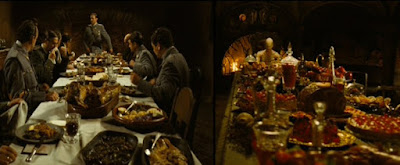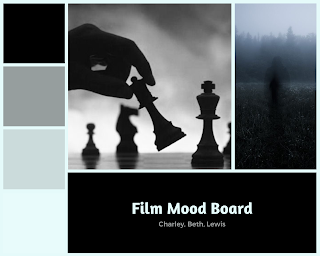Trainspotting Question
How does the aesthetic quality of 'Trainspotting' depict ideological issues of youth and addiction? Your answer must refer to two scenes.
The opening scene of Trainspotting, introduces the audience to the style and the main theme of the film, heroin addiction. The fast paced editing along side the quick, upbeat, non-diegetic music work together to create a high energy feeling, simulating the rush of being young and getting high. By adding Renton's voice over to the film the audience is given immediate insight into his ideological values, and from his accent and language they can make assumptions on his status in society. What he says in his voice over monologue, demonstrates his thoughts on society, he displays a distaste for the lives of ordinary people, he mocks them and his continuous swearing illustrates his anger at the norm; he ends his speech by explaining that he didn't choose life because he has heroin, which indicates Renton decided to destroy his chances of a normal life for a temporary high, highlighting how he fails to look far into his own future, instead he mostly thinks about heroin and when his next hit will be. In this scene, the film cuts to many different settings, the mise-en-scene of these settings presents to the audience the area in which these people live in, for example, the run-down building that Renton is shown smoking in implies that they are of a low social class. Through this opening sequence, we also get freeze frame introductions to each of the main characters Renton, Sick Boy, Begbie, Spud, and Tommy with non-diegetic text of their names next to their character, while this removes realism from the film it fits with the stylisation of the character's lifestyles making them out to seem like rock stars, which is backed up in other scenes where the characters are in similar poses to that from rock albums. Using the football scene Boyle is contrasting the main characters to their opponents, which is obvious from the full shot of both teams with every member in. The players that the main characters are opposing are portrayed as much more organised, from their mise-en-scene of costume, because their team have uniform, while the main character's are in their own clothes, therefore the protagonists' status is again shown to be low, as well as this the other team was shown as much more co-ordinated as they stood still in their group pose, whereas the main character's team had people falling. Renton's low status is implied to be because of his addiction, as when he gets clean he gets a job and has a fairly nice life, however when he is addicted he is shown throwing his life away for a hit, literally when he almost dies and when he almost goes to jail. Later in the film we are given context for what is happening in this scene, and that is that the characters are stealing to get money for their next hit, because they blew all of their own money on heroin. The upbeat nature of the scene from the music and the smiling characters is shadowed by the desperation of the characters for another hit.
A scene that demonstrates the dark nature of addiction would have to be the scene where the baby of Allison dies because of neglect. Unlike the opening scene, this scene is plunged into realism, so with this juxtaposition of style, the audience can tell the scene is serious. All of the noise in this scene is diegetic and the editing is slower paced, lacking jump cuts. Through most of the scene in the background, Allison is crying and moving around helplessly not knowing what to do, it's almost as if the non-diegetic music that is in the background of many scenes in the film is replaced by the wailing of this mother. In the hallway between the two doorways of the apartment, there are blue lights, which often has connotations with sorrow, foregrounding this scene as one of sadness. At first most of the characters are out of it, since they're still high, but they quickly started to sober up as they realised what was happening and rushed Allison and then to the baby's crib. There's a shot from the crib that looks at all the characters crowding around, showing their reactions, and then there's a shot from the side of the crib where you can see the legs of the child, from which the camera pans right revealing a close up of the whole dead body, this dark image highlights just how awful the situation is. The movie doesn't make it clear how the baby died, but it coveys that its due to neglect from everyone being too high to take care of her properly. Other scenes with the child in it foreshadowed something bad would happen, by the fact that she was usually left to crawl around alone in an area with dirty needles and drugs, though it doesn't make the scene any easier to watch. This grim scene highlights how addiction doesn't just harm the addict but also the innocent people around them. Renton in his voice over explains how he wanted to say "something human" in response to the situation, but instead when Sick Boy yells at him to say something, he says that he's going to cook up some heroin, thus implying that what he said wasn't human, that his addiction has taken away his humanity. This is further conveyed by the mid shot of Sick Boy at the cot crying alone, while the others instead decide to forget with heroin, including the mother of the baby Allison, who crawls over to Renton in desperation for another hit, the body language of Allison portrays their reliance on heroin because of their addiction. Though, as Renton says in his voice over, this changes something inside of Sick Boy, which causes him to get clean, demonstrating that people's ideologies can change because of important events.
The opening scene of Trainspotting, introduces the audience to the style and the main theme of the film, heroin addiction. The fast paced editing along side the quick, upbeat, non-diegetic music work together to create a high energy feeling, simulating the rush of being young and getting high. By adding Renton's voice over to the film the audience is given immediate insight into his ideological values, and from his accent and language they can make assumptions on his status in society. What he says in his voice over monologue, demonstrates his thoughts on society, he displays a distaste for the lives of ordinary people, he mocks them and his continuous swearing illustrates his anger at the norm; he ends his speech by explaining that he didn't choose life because he has heroin, which indicates Renton decided to destroy his chances of a normal life for a temporary high, highlighting how he fails to look far into his own future, instead he mostly thinks about heroin and when his next hit will be. In this scene, the film cuts to many different settings, the mise-en-scene of these settings presents to the audience the area in which these people live in, for example, the run-down building that Renton is shown smoking in implies that they are of a low social class. Through this opening sequence, we also get freeze frame introductions to each of the main characters Renton, Sick Boy, Begbie, Spud, and Tommy with non-diegetic text of their names next to their character, while this removes realism from the film it fits with the stylisation of the character's lifestyles making them out to seem like rock stars, which is backed up in other scenes where the characters are in similar poses to that from rock albums. Using the football scene Boyle is contrasting the main characters to their opponents, which is obvious from the full shot of both teams with every member in. The players that the main characters are opposing are portrayed as much more organised, from their mise-en-scene of costume, because their team have uniform, while the main character's are in their own clothes, therefore the protagonists' status is again shown to be low, as well as this the other team was shown as much more co-ordinated as they stood still in their group pose, whereas the main character's team had people falling. Renton's low status is implied to be because of his addiction, as when he gets clean he gets a job and has a fairly nice life, however when he is addicted he is shown throwing his life away for a hit, literally when he almost dies and when he almost goes to jail. Later in the film we are given context for what is happening in this scene, and that is that the characters are stealing to get money for their next hit, because they blew all of their own money on heroin. The upbeat nature of the scene from the music and the smiling characters is shadowed by the desperation of the characters for another hit.
A scene that demonstrates the dark nature of addiction would have to be the scene where the baby of Allison dies because of neglect. Unlike the opening scene, this scene is plunged into realism, so with this juxtaposition of style, the audience can tell the scene is serious. All of the noise in this scene is diegetic and the editing is slower paced, lacking jump cuts. Through most of the scene in the background, Allison is crying and moving around helplessly not knowing what to do, it's almost as if the non-diegetic music that is in the background of many scenes in the film is replaced by the wailing of this mother. In the hallway between the two doorways of the apartment, there are blue lights, which often has connotations with sorrow, foregrounding this scene as one of sadness. At first most of the characters are out of it, since they're still high, but they quickly started to sober up as they realised what was happening and rushed Allison and then to the baby's crib. There's a shot from the crib that looks at all the characters crowding around, showing their reactions, and then there's a shot from the side of the crib where you can see the legs of the child, from which the camera pans right revealing a close up of the whole dead body, this dark image highlights just how awful the situation is. The movie doesn't make it clear how the baby died, but it coveys that its due to neglect from everyone being too high to take care of her properly. Other scenes with the child in it foreshadowed something bad would happen, by the fact that she was usually left to crawl around alone in an area with dirty needles and drugs, though it doesn't make the scene any easier to watch. This grim scene highlights how addiction doesn't just harm the addict but also the innocent people around them. Renton in his voice over explains how he wanted to say "something human" in response to the situation, but instead when Sick Boy yells at him to say something, he says that he's going to cook up some heroin, thus implying that what he said wasn't human, that his addiction has taken away his humanity. This is further conveyed by the mid shot of Sick Boy at the cot crying alone, while the others instead decide to forget with heroin, including the mother of the baby Allison, who crawls over to Renton in desperation for another hit, the body language of Allison portrays their reliance on heroin because of their addiction. Though, as Renton says in his voice over, this changes something inside of Sick Boy, which causes him to get clean, demonstrating that people's ideologies can change because of important events.


Comments
Post a Comment